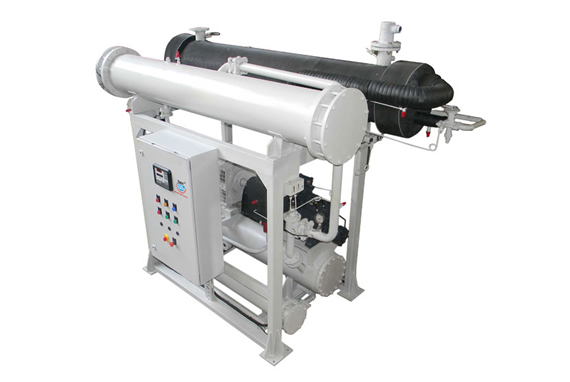Introduction
Brine chillers are specialized cooling systems designed to achieve precise and consistent temperature control, especially for applications requiring subzero cooling. These systems utilize brine, a mixture of water with salts (such as sodium chloride or calcium chloride) or antifreeze agents (like glycol), as a secondary coolant. By leveraging brine’s excellent thermal properties, these chillers can efficiently manage heat transfer even in extreme conditions. Industries like food processing, pharmaceuticals, chemical manufacturing, and large-scale HVAC systems rely on brine chillers for their ability to maintain critical temperature thresholds while ensuring energy-efficient operations. With advancements in technology, brine chillers have evolved to meet diverse industrial needs, offering enhanced reliability, scalability, and environmental compliance.
Purpose and Function
Brine chillers are used in industries where standard cooling methods are insufficient, especially for subzero temperatures. These chillers cool brine, a secondary coolant, which then circulates through a system to absorb heat from processes or equipment. This indirect cooling method ensures safe and effective temperature control, minimizing risks of freezing or contamination. For example, in food processing, brine chillers maintain consistent low temperatures essential for preserving quality and safety.
Working Principle
Brine chillers rely on either a vapor compression cycle or an absorption refrigeration cycle:
- Vapor Compression Cycle: Refrigerant in the compressor absorbs heat from the brine via a heat exchanger. The brine, now chilled, is circulated to the cooling points.
- Absorption Cycle: Uses heat (from sources like steam) to drive the cooling process, making it energy-efficient in facilities with excess heat.
The brine, a secondary coolant, prevents freezing and improves thermal efficiency by offering better heat absorption than water.
Types of Brine Solutions
- Sodium Chloride Brine: Suitable for moderate cooling applications (down to -15°C). Common in food and beverage storage.
- Calcium Chloride Brine: Provides better freezing point depression, ideal for extreme cooling needs (as low as -40°C). Widely used in industrial and ice production.
- Propylene/Ethylene Glycol Solutions: Non-toxic and antifreeze alternatives, perfect for HVAC systems, pharmaceutical applications, and environments sensitive to contamination.
Each brine type is selected based on the cooling range, environmental conditions, and specific industry requirements.
Applications of Brine chillers
- Food and Beverage Industry:
Brine chillers are critical for freezing meat, fish, and poultry; cooling beverages during production; and maintaining temperature in storage facilities. Their ability to sustain low temperatures ensures product longevity and quality. - Pharmaceutical Industry:
Essential for cooling sensitive drugs, vaccines, and chemical reactions during production. They also maintain temperature stability in pharmaceutical storage facilities. - Chemical Plants:
In chemical reactions that release heat, brine chillers provide rapid cooling to prevent overheating and ensure process stability. They also support exothermic reaction control in reactors. - HVAC Systems:
Large-scale buildings, shopping malls, and ice rinks use brine chillers for comfort cooling and specialized applications, like creating and maintaining ice surfaces.
Components of Brine Chillers
- Compressor: The powerhouse of the system, compressing the refrigerant to high pressure and temperature, enabling efficient heat transfer.
- Heat Exchanger: Facilitates the exchange of heat between brine and the refrigerant, ensuring rapid cooling.
- Brine Tank: A storage reservoir for the chilled brine before distribution, ensuring a steady supply during operations.
- Pumps: Circulate the brine through pipelines, maintaining uniform cooling across all connected areas or equipment.
- Control Systems: Automated sensors and regulators monitor pressure, temperature, and flow, optimizing performance and ensuring system safety.
Advantages
- Low-Temperature Capability: Can consistently deliver temperatures far below freezing, essential for processes like cryogenics and ice production.
- Energy Efficiency: Advanced designs ensure minimal energy consumption, reducing operational costs over time.
- Versatility: Suitable for various industrial applications, from food processing to heavy chemical manufacturing.
- Durability and Reliability: Engineered with robust materials to withstand harsh conditions and prolonged use without frequent breakdowns.
Challenges and Considerations of Brine chillers
- Corrosion Risks: Salt-based brine solutions can corrode internal components, necessitating corrosion-resistant materials like stainless steel or specialized coatings.
- Maintenance Requirements: Regular cleaning and inspection are essential to prevent scaling, clogging, or fouling, which can reduce efficiency.
- Initial Cost: High-quality materials and complex designs make brine chillers more expensive upfront, though they offer long-term savings through durability and energy efficiency.
- Environmental Concerns: Disposal of used brine requires careful handling to prevent contamination of water sources or soil.
Environmental Impact
Modern brine chillers focus on sustainability by utilizing low-global warming potential (GWP) refrigerants, minimizing ozone depletion risks. Proper disposal of brine solutions and the use of eco-friendly additives further mitigate environmental harm, aligning industrial processes with environmental regulations.
Customization and Scalability on Brine chillers
Brine chillers are highly adaptable to varying industrial needs:
- Small-Scale Systems: Suitable for laboratories or specialized manufacturing units.
- Large-Scale Systems: Designed for heavy-duty industrial processes, such as chemical plants or cold storage warehouses.
- Custom Features: Options like modular designs, advanced control panels, and material upgrades allow industries to tailor chillers for specific operational requirements.
Conclusion
Brine chillers represent a cornerstone of industrial cooling systems, addressing the unique challenges of applications requiring low and subzero temperatures. Their design and operation offer a perfect balance of precision, efficiency, and reliability, making them indispensable for industries like food preservation, pharmaceuticals, and chemical processing. Despite challenges such as corrosion risks and maintenance needs, modern brine chillers incorporate innovative features, such as corrosion-resistant materials, automated control systems, and eco-friendly refrigerants, to overcome these limitations and ensure long-lasting performance. Furthermore, their adaptability to varying scales and customization options make them a versatile solution for both small-scale and large-scale applications.

